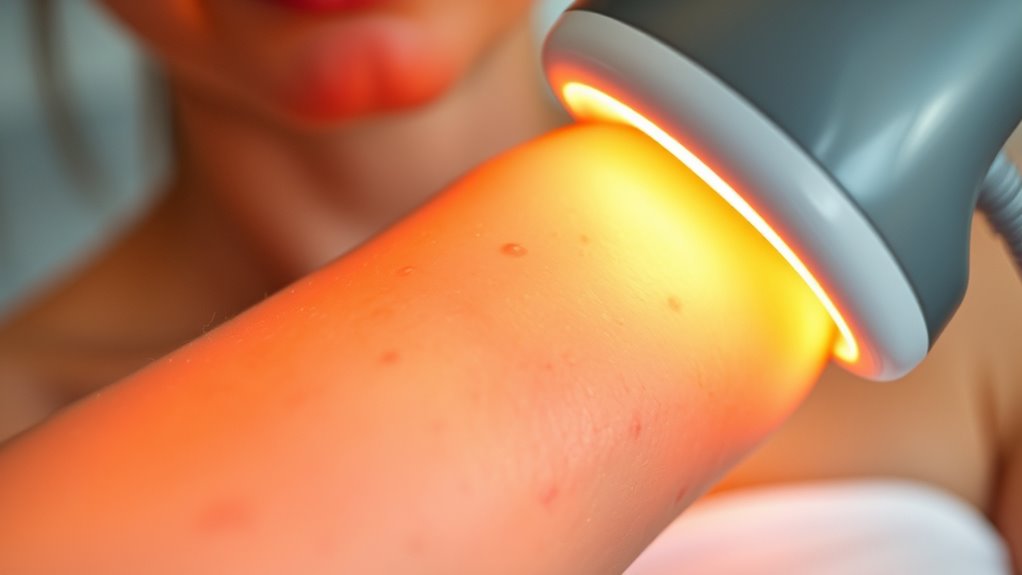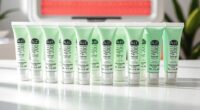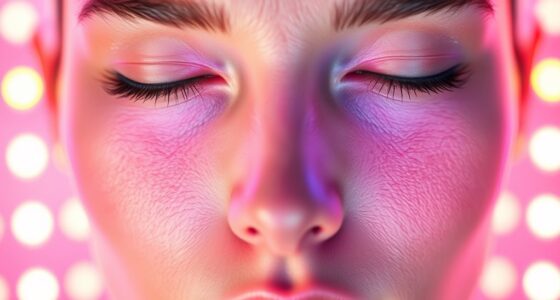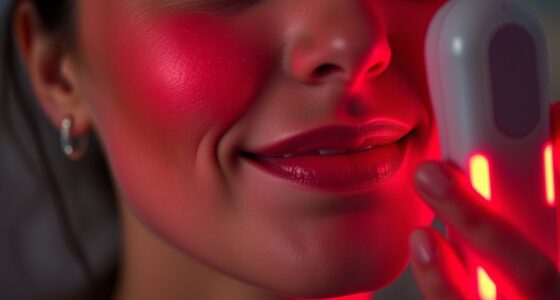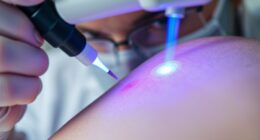Light therapy can be an effective way to reduce red bumps from keratosis pilaris on your arms. It works by targeting inflammation, calming irritated skin, and encouraging healthy cell turnover deep within your skin. Sessions are quick and non-invasive, often showing gradual improvement over several weeks. By using specific wavelengths of light, you can expect smoother, less red skin without harsh treatments. Keep exploring to discover how this gentle approach can help your skin feel and look better.
Key Takeaways
- Light therapy can reduce redness and smooth bumps caused by keratosis pilaris on the arms.
- It works by penetrating deep to calm inflammation and promote healthy skin cell turnover.
- Regular sessions with specialized devices may improve skin texture over several weeks.
- Minimal side effects like mild redness or dryness usually subside quickly during treatment.
- Combining light therapy with good skincare enhances results and helps manage KP effectively.
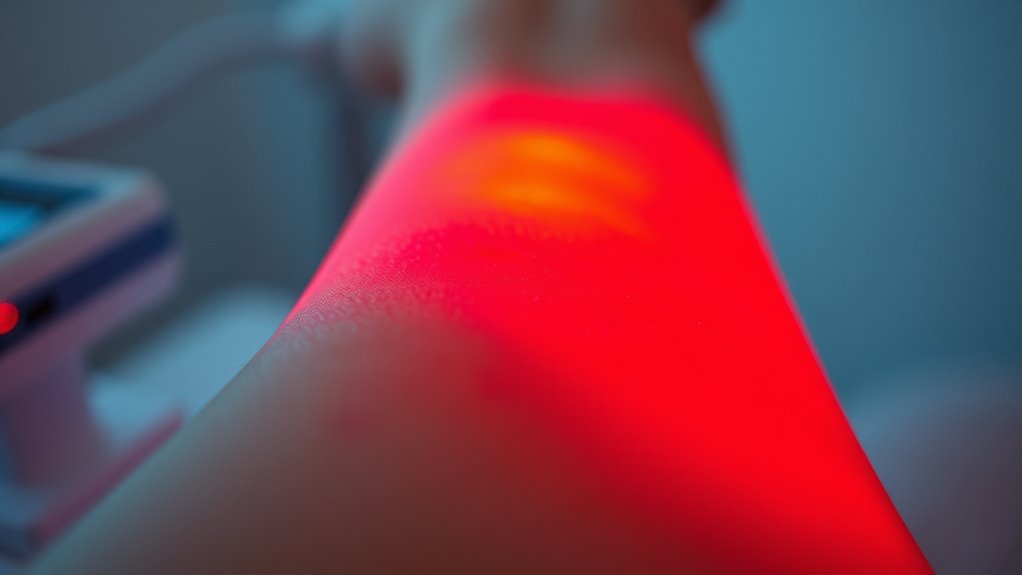
If you’re struggling with red bumps on your arms, light therapy might offer an effective solution. These bumps, often caused by keratosis pilaris (KP), can be frustrating and difficult to manage. Traditional treatments like moisturizers and exfoliants sometimes provide limited relief, leaving you searching for more effective options. Light therapy presents a promising alternative because it targets inflammation and promotes skin healing at a cellular level. This treatment involves exposing your skin to specific wavelengths of light, which can reduce redness, smooth out bumps, and improve your skin’s overall appearance.
Light therapy reduces redness and smooths bumps caused by keratosis pilaris.
When you opt for light therapy, you’re essentially giving your skin a gentle boost. The process usually involves sessions with specialized light devices or lamps that emit either narrowband UVB, red light, or other safe wavelengths. These lights penetrate deep into your skin, reducing inflammation and calming irritated areas. Unlike topical creams, light therapy addresses the root causes of KP by modulating your immune response and encouraging healthier skin cell turnover. Over time, this can lead to a noticeable decrease in redness and bump formation, making your arms look smoother and more even.
One of the key advantages of light therapy is its non-invasive nature. You don’t need to worry about painful procedures or harsh chemicals. Instead, you sit comfortably while the light does its work, usually for a few minutes per session. Many people find that they experience minimal side effects, with some mild redness or dryness that typically subsides quickly. Consistency plays a crucial role in seeing results; regular sessions over several weeks can markedly improve your skin’s texture and tone. It’s important to follow your healthcare provider’s recommendations on session frequency and duration to maximize benefits.
While light therapy can be highly effective, it’s not a quick fix. You should expect gradual improvements as your skin responds to treatment. It’s also essential to combine light therapy with good skincare habits, like moisturizing regularly and avoiding irritating products. Keep in mind that results vary depending on the severity of your KP and your skin’s unique response. Some individuals notice a reduction in redness and bumps within a few weeks, while others may need longer-term treatment. Consulting with a dermatologist can help you develop a tailored plan that fits your needs and ensures safe use of light therapy.
Frequently Asked Questions
How Long Does It Take to See Results With Light Therapy?
You can typically start seeing results within 4 to 6 weeks of consistent light therapy sessions. It’s important to follow your treatment plan closely and use the device as directed. Some people notice improvements sooner, while others may need a few months for significant changes. Patience is key, and combining light therapy with proper skin care can help you achieve the best results faster.
Is Light Therapy Safe for All Skin Types?
Light therapy is generally safe for most skin types, but you should verify with your dermatologist first. People with darker skin tones might need special considerations to avoid pigmentation changes. While side effects are rare, some may experience temporary redness or irritation. Always follow your provider’s instructions, and inform them of your skin type and any sensitivities. This ensures the treatment is safe and effective for you.
Can Light Therapy Be Combined With Other Treatments?
Yes, you can combine light therapy with other treatments for red bumps on your arms. Many people use it alongside moisturizers, topical medications, or exfoliation to enhance results. Just make sure to consult your dermatologist first, so they can recommend safe combinations tailored to your skin type. Combining treatments often speeds up healing and improves skin texture, but professional guidance guarantees you avoid irritation or adverse effects.
Are There Any Side Effects From Light Therapy?
Yes, light therapy can cause side effects. You might notice skin irritation, redness, or dryness after treatment. Some people experience mild discomfort or burning sensations. Rarely, it could lead to pigmentation changes or eye strain if proper protection isn’t employed. To minimize risks, follow your healthcare provider’s instructions carefully, and report any adverse reactions promptly to ensure safe and effective treatment.
How Often Should I Undergo Light Therapy Sessions?
How often should you undergo light therapy? Think of it like tending a garden—you need to nurture it consistently. Typically, you’ll have sessions 2-3 times a week, but your dermatologist will tailor this to your skin’s response. Follow their guidance closely, and don’t skip appointments. Regular treatments help your skin heal and clear up faster, turning your efforts into a thriving, healthier complexion.
Conclusion
While light therapy shows promise in reducing red bumps on your arms, some experts believe it works by calming inflammation rather than directly targeting the bumps themselves. Though more research is needed, evidence suggests that consistent treatment may help improve your skin’s appearance over time. Keep in mind, everyone’s skin responds differently—so it’s wise to consult a dermatologist to see if light therapy is the right option for your specific condition.
